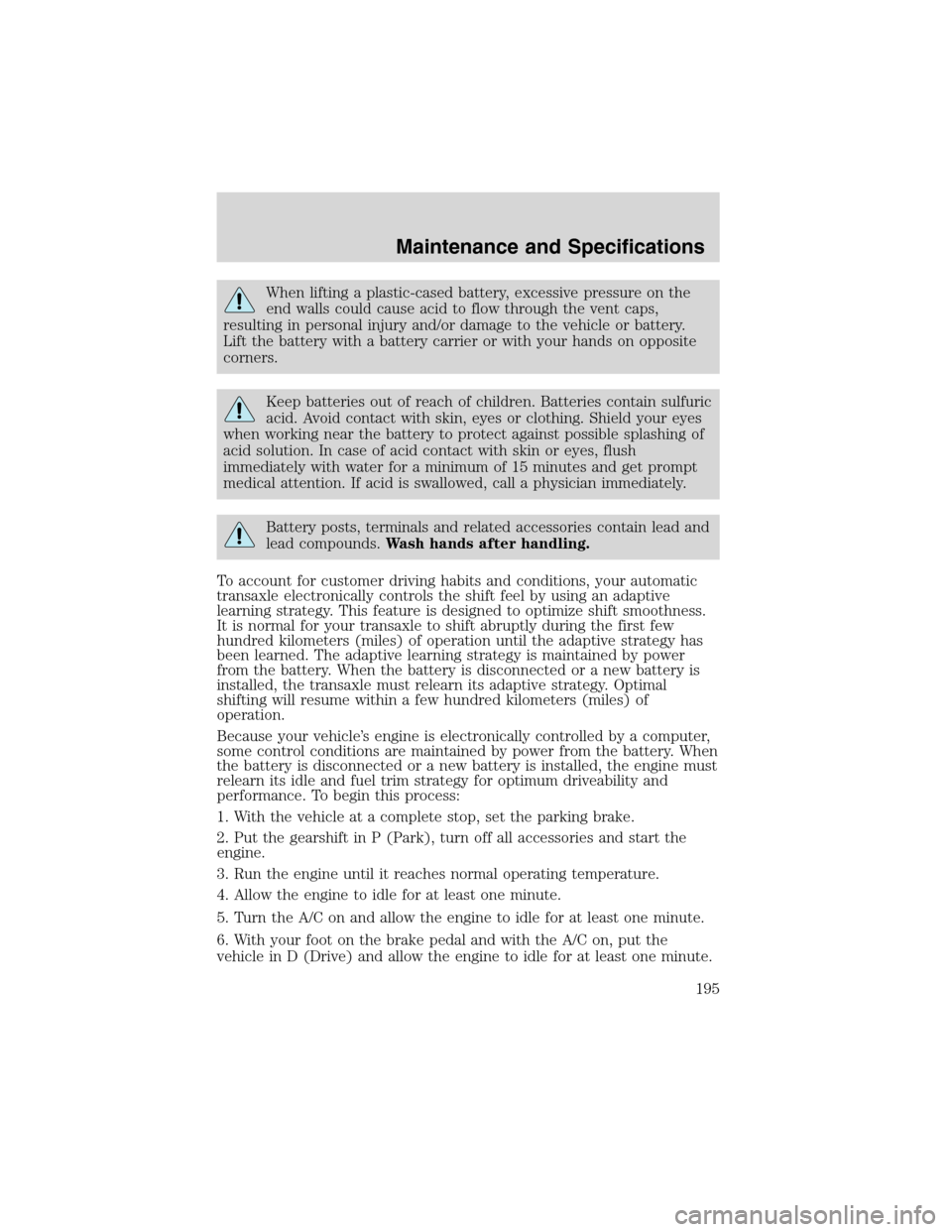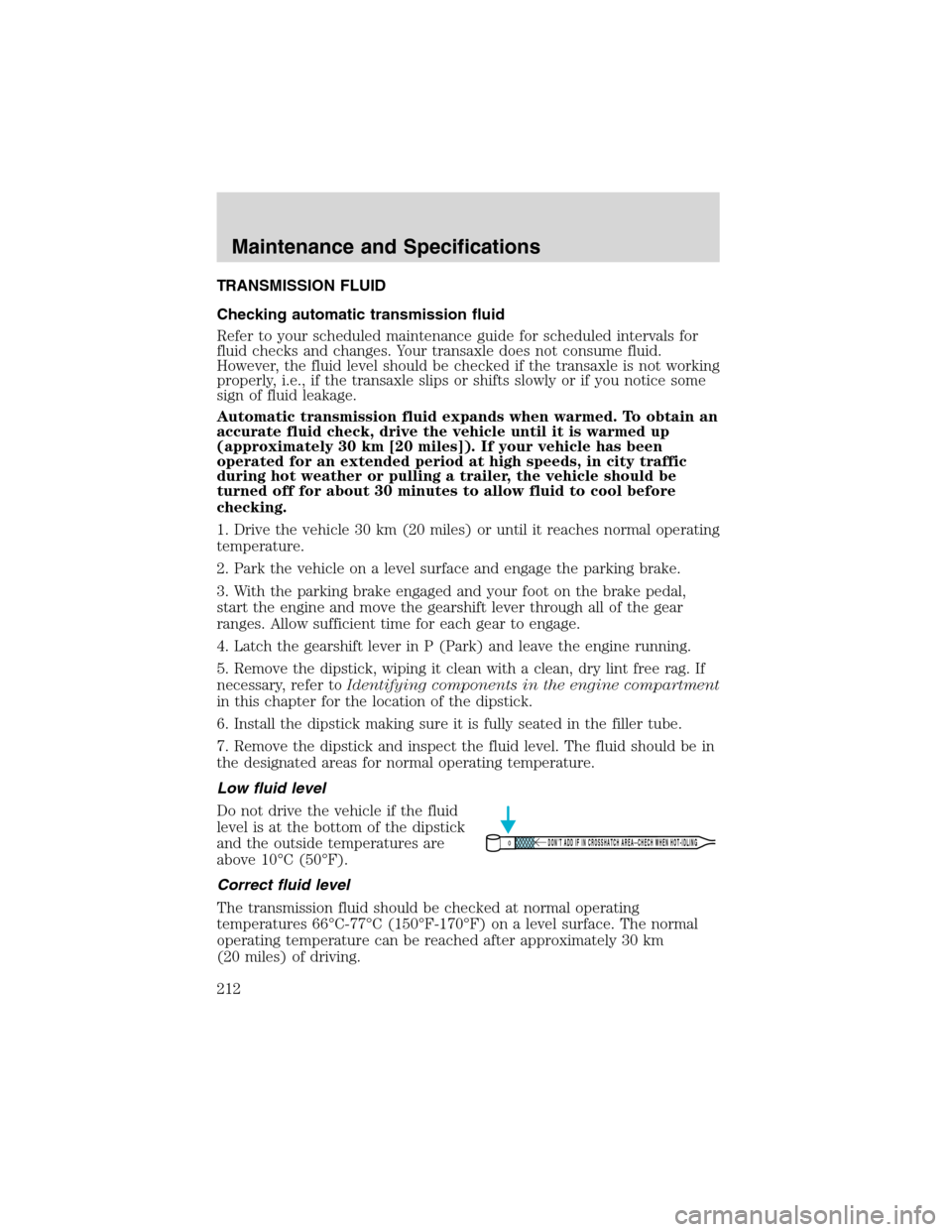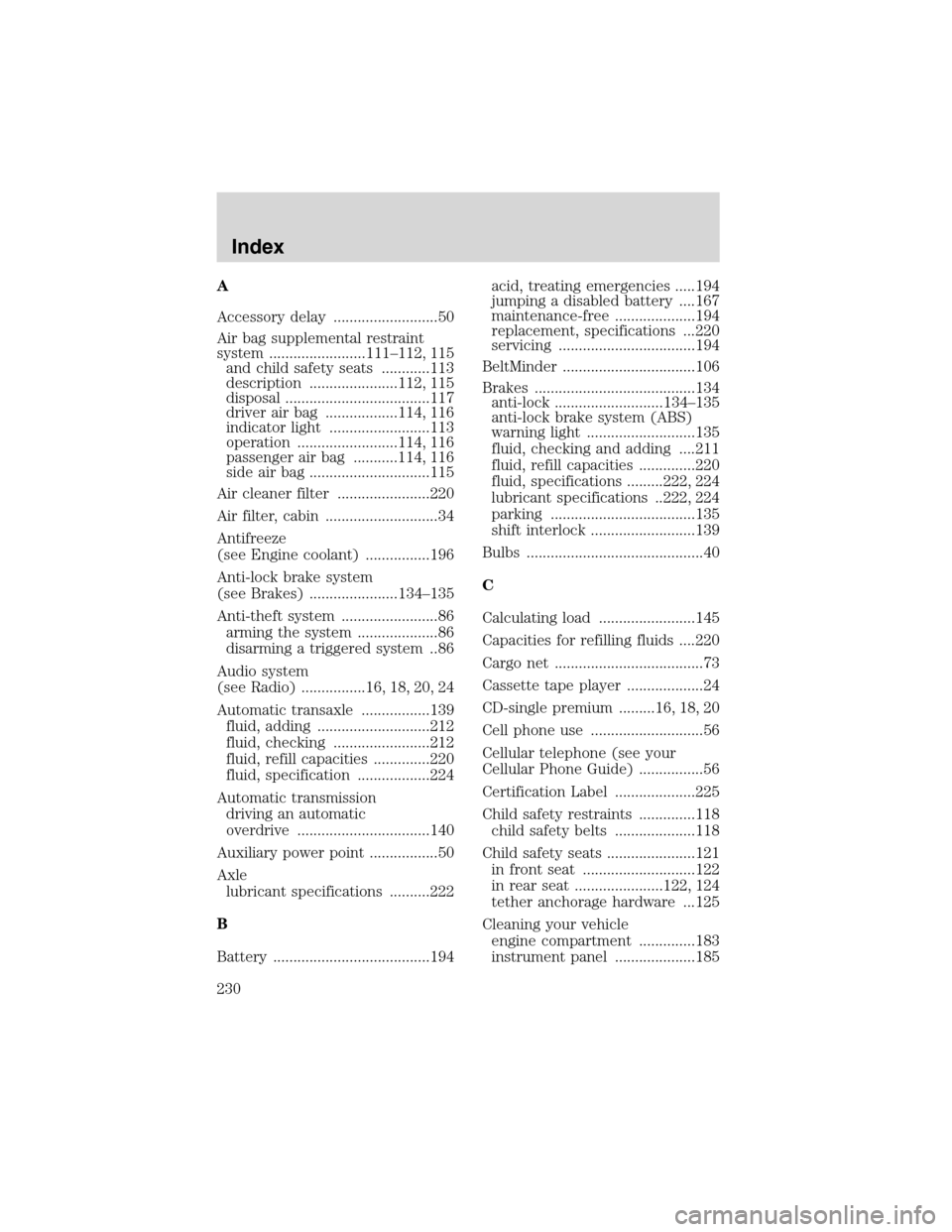2003 FORD WINDSTAR parking brake
[x] Cancel search: parking brakePage 192 of 240

1. Make sure the vehicle is on level ground.
2. Turn the engine off and wait a few minutes for the oil to drain into the
oil pan.
3. Set the parking brake and ensure the gearshift is securely latched in P
(Park).
4. Open the hood. Protect yourself from engine heat.
5. Locate and carefully remove the
engine oil level indicator (dipstick).
6. Wipe the indicator clean. Insert the indicator fully, then remove it
again.
•If the oil level isbetween the MIN and MAX marks,the oil level is
acceptable.DO NOT ADD OIL.
•If the oil level is below the MIN
mark, add enough oil to raise the
level within the MIN-MAX range.
MAX MIN
Maintenance and Specifications
192
Page 195 of 240

When lifting a plastic-cased battery, excessive pressure on the
end walls could cause acid to flow through the vent caps,
resulting in personal injury and/or damage to the vehicle or battery.
Lift the battery with a battery carrier or with your hands on opposite
corners.
Keep batteries out of reach of children. Batteries contain sulfuric
acid. Avoid contact with skin, eyes or clothing. Shield your eyes
when working near the battery to protect against possible splashing of
acid solution. In case of acid contact with skin or eyes, flush
immediately with water for a minimum of 15 minutes and get prompt
medical attention. If acid is swallowed, call a physician immediately.
Battery posts, terminals and related accessories contain lead and
lead compounds.Wash hands after handling.
To account for customer driving habits and conditions, your automatic
transaxle electronically controls the shift feel by using an adaptive
learning strategy. This feature is designed to optimize shift smoothness.
It is normal for your transaxle to shift abruptly during the first few
hundred kilometers (miles) of operation until the adaptive strategy has
been learned. The adaptive learning strategy is maintained by power
from the battery. When the battery is disconnected or a new battery is
installed, the transaxle must relearn its adaptive strategy. Optimal
shifting will resume within a few hundred kilometers (miles) of
operation.
Because your vehicle’s engine is electronically controlled by a computer,
some control conditions are maintained by power from the battery. When
the battery is disconnected or a new battery is installed, the engine must
relearn its idle and fuel trim strategy for optimum driveability and
performance. To begin this process:
1. With the vehicle at a complete stop, set the parking brake.
2. Put the gearshift in P (Park), turn off all accessories and start the
engine.
3. Run the engine until it reaches normal operating temperature.
4. Allow the engine to idle for at least one minute.
5. Turn the A/C on and allow the engine to idle for at least one minute.
6. With your foot on the brake pedal and with the A/C on, put the
vehicle in D (Drive) and allow the engine to idle for at least one minute.
Maintenance and Specifications
195
Page 212 of 240

TRANSMISSION FLUID
Checking automatic transmission fluid
Refer to your scheduled maintenance guide for scheduled intervals for
fluid checks and changes. Your transaxle does not consume fluid.
However, the fluid level should be checked if the transaxle is not working
properly, i.e., if the transaxle slips or shifts slowly or if you notice some
sign of fluid leakage.
Automatic transmission fluid expands when warmed. To obtain an
accurate fluid check, drive the vehicle until it is warmed up
(approximately 30 km [20 miles]). If your vehicle has been
operated for an extended period at high speeds, in city traffic
during hot weather or pulling a trailer, the vehicle should be
turned off for about 30 minutes to allow fluid to cool before
checking.
1. Drive the vehicle 30 km (20 miles) or until it reaches normal operating
temperature.
2. Park the vehicle on a level surface and engage the parking brake.
3. With the parking brake engaged and your foot on the brake pedal,
start the engine and move the gearshift lever through all of the gear
ranges. Allow sufficient time for each gear to engage.
4. Latch the gearshift lever in P (Park) and leave the engine running.
5. Remove the dipstick, wiping it clean with a clean, dry lint free rag. If
necessary, refer toIdentifying components in the engine compartment
in this chapter for the location of the dipstick.
6. Install the dipstick making sure it is fully seated in the filler tube.
7. Remove the dipstick and inspect the fluid level. The fluid should be in
the designated areas for normal operating temperature.
Low fluid level
Do not drive the vehicle if the fluid
level is at the bottom of the dipstick
and the outside temperatures are
above 10°C (50°F).
Correct fluid level
The transmission fluid should be checked at normal operating
temperatures 66°C-77°C (150°F-170°F) on a level surface. The normal
operating temperature can be reached after approximately 30 km
(20 miles) of driving.
DON’T ADD IF IN CROSSHATCH AREA--CHECH WHEN HOT-IDLING
Maintenance and Specifications
212
Page 230 of 240

A
Accessory delay ..........................50
Air bag supplemental restraint
system ........................111–112, 115
and child safety seats ............113
description ......................112, 115
disposal ....................................117
driver air bag ..................114, 116
indicator light .........................113
operation .........................114, 116
passenger air bag ...........114, 116
side air bag ..............................115
Air cleaner filter .......................220
Air filter, cabin ............................34
Antifreeze
(see Engine coolant) ................196
Anti-lock brake system
(see Brakes) ......................134–135
Anti-theft system ........................86
arming the system ....................86
disarming a triggered system ..86
Audio system
(see Radio) ................16, 18, 20, 24
Automatic transaxle .................139
fluid, adding ............................212
fluid, checking ........................212
fluid, refill capacities ..............220
fluid, specification ..................224
Automatic transmission
driving an automatic
overdrive .................................140
Auxiliary power point .................50
Axle
lubricant specifications ..........222
B
Battery .......................................194acid, treating emergencies .....194
jumping a disabled battery ....167
maintenance-free ....................194
replacement, specifications ...220
servicing ..................................194
BeltMinder .................................106
Brakes ........................................134
anti-lock ...........................134–135
anti-lock brake system (ABS)
warning light ...........................135
fluid, checking and adding ....211
fluid, refill capacities ..............220
fluid, specifications .........222, 224
lubricant specifications ..222, 224
parking ....................................135
shift interlock ..........................139
Bulbs ............................................40
C
Calculating load ........................145
Capacities for refilling fluids ....220
Cargo net .....................................73
Cassette tape player ...................24
CD-single premium .........16, 18, 20
Cell phone use ............................56
Cellular telephone (see your
Cellular Phone Guide) ................56
Certification Label ....................225
Child safety restraints ..............118
child safety belts ....................118
Child safety seats ......................121
in front seat ............................122
in rear seat ......................122, 124
tether anchorage hardware ...125
Cleaning your vehicle
engine compartment ..............183
instrument panel ....................185
Index
230
Page 233 of 240

K
Keyless entry system .................81
autolock .....................................81
Keys
positions of the ignition .........131
L
Lamps
autolamp system .......................35
bulb replacement
specifications chart ..................40
cargo lamps ...............................36
daytime running light ...............35
headlamps .................................35
headlamps, flash to pass ..........36
instrument panel, dimming .....36
interior lamps .....................38–39
replacing bulbs .............40, 42–43
Lane change indicator
(see Turn signal) ........................38
Liftgate ..................................72–73
Lights, warning and indicator ....10
anti-lock brakes (ABS) ..........135
Load limits .................................144
GAWR ......................................144
GVWR ......................................144
trailer towing ..........................144
Locks
autolock .....................................81
childproof ..................................76
Low tire warning .................13, 215
Lubricant specifications ...222, 224
Lumbar support, seats ...............89
M
Message center ...........................62english/metric button ...............63
system check button ................63
warning messages .....................65
Mirrors .........................................46
automatic dimming rearview
mirror ........................................51
fold away ...................................52
heated ........................................52
side view mirrors (power) .......51
Motorcraft parts ................205, 220
O
Octane rating ............................204
Oil (see Engine oil) ..................191
Overdrive ...................................139
P
Parking brake ............................135
Parts (see Motorcraft parts) ....220
Passenger Occupant
Classification Sensor ...................99
Pedals (see Power adjustable
foot pedals) .................................53
Power adjustable foot pedals .....53
Power distribution box
(see Fuses) ...............................157
Power door locks ..................75, 81
Power mirrors .............................51
Power point .................................50
Power steering ..........................138
fluid, checking and adding ....211
fluid, refill capacity ................220
fluid, specifications .........222, 224
Power Windows ...........................50
R
Radio ..........................16, 18, 20, 24
Index
233